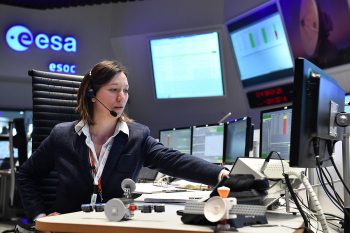Mars atmosphere grabs our spacecraft
Got an update on TGO aerobraking progress at mid-day today from Silvia Sangiorgi, our deputy spacecraft operations manager here at ESOC. She wrote:

ExoMars/TGO Deputy Spacecraft Operations Manager Silvia Sangiorgi seen in the Main Control Room at ESOC during launch in March 2016. Credit: ESA/J. Mai
PLM 1 [on 15 March] was nominal. [Since then] we have already had two percienter (= periapsis – point of closest approach above Mars) passes at 150 km height; they gave us, respectively, 11 and 10 mm/sec of delta V. All is nominal and working fine for the moment 🙂 PLM 2 will be tomorrow at 11:45 UTC (12:45 CET); it will bring us a further 10 km down. Flight dynamics are producing the commands now – these will be uplinked tonight. Ciao, Silvia
Tomorrow’s burn is planned to provide a delta-v (change in velocity) of 58 cm/sec and targets a pericenter hight of 140 km.
If the team are already seeing ‘changes in velocity’ due to the atmosphere on the order of 10 to 11 mm/second, then TGO is already ‘feeling the burn’.
PLM refers to ‘pericentre lowering manoeuvre’ – how the engineers on the TGO team refer to the seven (planned) thruster burns that are slowing TGO, allowing it to sink, step-wise, lower in its orbit until atmospheric drag reaches a certain load. Then we’ll be in aerobraking proper!
The seven manoeuvres are planned for:
- March: 15, 18, 21, 24 and 27
- April: 1 and 6
Read yesterday’s blog post Hang 10 over Mars for full background.
Note that pericentre and periapsis, and apocentre and apoapsis are, when referring to Mars, often used interchangeably.

Discussion: no comments